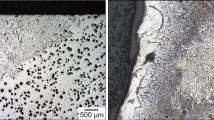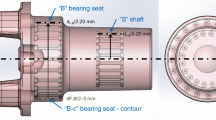Conclusions
The presence of the graphite inclusions in the structure of the cast iron greatly affects the cyclic cracking resistance as a result of an increase of the dissipation of energy during crack growth and its closure. The dissipative processes lead to branching, blunting, and deviation of the crack from the plane of action of the highest normal stresses. This inhibits crack propagation. The effect of these processes is maximum at low crack growth rates and decreases with increase in AK. At FCG in cast irons failure takes place both in the graphite particles and at the matrix-graphite interface boundaries with the graphite inclusions displaced to the fracture surface. Being the highest elements of the relief of the fracture surface, the graphite particles increase its roughness and determine the mechanism and level of the CC. The described special features of the behavior of graphite in the cast irons during FCG indicate the following:
-
at low crack propagation rates (below 10 -9 m/cycle) the CCT of the cast irons is, irrespective of the form of the graphite inclusions, higher than in the steels with similar structures;
-
at rates higher than i0 -s m/cycle, the CCT of the cast irons with matrix of the same structure depends not only on the form of graphite but also on the crack growth rate;
-
the specific features of FCG in the cast irons with plate-shaped inclusions of graphite (high AKth and curvature KDFF) causes that GCI cannot be used for machine components operating under cyclic loading conditions;
-
the structure of the metallic matrix in the cast irons with vermicular graphite particles does not effect the CCT;
-
in cast irons with nodular graphite, the CCT at low rates of FCG increases with an increase of the size of globules and strength of the matrix;
-
in the cast irons with the nodular and vermicular graphite with the same structure of the matrix, the CCT depends on the strength of the matrix and its capacity to relax local stresses;
-
the cast irons with nodular and vermicular graphite inclusions are capable of competing with the structural steels in respect of their CCT.
Similar content being viewed by others
Literature cited
O. N. Romaniv, A. N. Tkach, T. Ya. Yus'kiv, et al., “Fatigue crack growth in cast irons. I. Nodular graphite cast iron,” Fiz.-Khim. Mekh. Mater., No. 4, 73–79 (1989).
O. N. Romaniv, A. N. Tkach, T. Ya. Yus'kiv, et al., “Static cracking resistance of cast irons. I. Gray and malleable cast irons,” Fiz.-Khim. Mekh. Mater., No. 6, 30–36 (1988).
A. N. Tkach, I. V. Lysak, T. Ya. Yus'kiv, et al., “Special features of the method of determining the static cracking resistance of cast irons,” Fiz.-Khim. Mekh. Mater., No. 1, 68–73.
O. N. Romaniv and A. N. Tkach, “Structural analysis of the kinetic diagrams of fatigue failure of structural steels,” Fiz.-Khim. Mekh. Mater., No. 5, 3–16 (1987).
P. Clement, J. P. Angeli, and A. Pineau, “A short crack behaviour in nodular cast iron,” Fat. Eng. Mater. Struct.,7, No. 4, 251–265 (1984).
M. O. Speidel, “Fracture strength and fatigue cracking in cast iron,” Z. Werkstofftech,12, 387–402 (1981).
A. Ya. Krasovskii, V. V. Kalaida, and I. V. Kramarenko, “Cyclic cracking resistance of nodular cast irons,” Probl. Proch., No. 5, 12–18 (1985).
A. Glouver and H. Pollard, “Effect of the microstructure on the fracture toughness of gray cast iron,” in: Fracture Toughness of High-Strength Materials [Russian translation], Metallurgy, Moscow (1973), pp. 152–161.
E. Hornbogen, “Fracture toughness and fatigue crack growth of grey cast irons,” J. Mater. Sci.,20, 3895–3905 (1985).
K. H. Bowe, E. Hornbogen, and St. Stanzl,. “Definition, measurement, and application of fracture mechanics values for gray cast iron,” Konstruieren-giessen,11, No. 2, 23–32 (1986).
O. N. Romaniv, E. A. Shur, A. N. Tkach, et al., “Kinetics and growth of mechanism of a fatigue crack in iron,” Fiz.-Khim. Mekh. Mater., No. 2, 57–66 (1981).
O. N. Romaniv, G. N. Nikiforchin, and B. N. Andrusiv, “Effect of closure and geometry of fatigue cracks on the structural sensitivity of near-threshold fatigue of steels,” Fiz.-Khim. Mekh. Mater., No. 1, 71–77 (1984).
B. A. Bilby, G. E. Cardew, and J. C. Howards, “Stress intensity factors at the tip of kirked and forked cracks,” in: Fracture [Edited by D. M. R. Taplin], Vol. 3, University of Waterloo Press, Waterloo (1977), pp. 197–200.
S. Suresh, “Fatigue crack deflection and fracture surface contact: micromechanical models,” Met. Trans.,18A, No. 2, 249–260 (1985).
R. O. Ritchie and J. F. Knott, “Microcleavage cracking during fatigue crack propagation in low strength steel,” Mater. Sci. Eng.,14, No. l, 7–14 (1974).
O. N. Romaniv, E. A. Shchur, V. N. Simin'kovich, et al., “Cracking resistance of pearlitic eutectic steels. I. Fracture in cyclic loading,” Fiz.-Khim. Mekh. Mater., No. 2, 37–45 (1983).
Author information
Authors and Affiliations
Additional information
Translated from Fiziko-Khimicheskaya Mekhanika Materialov, No. 3, pp. 33–40, May–June, 1990.
Rights and permissions
About this article
Cite this article
Romaniv, O.N., Tkach, A.N., Yus'kiv, T.Y. et al. Growth of a fatigue crack in cast irons. II. Gray and malleable cast irons. Mater Sci 26, 274–281 (1990). https://doi.org/10.1007/BF00727357
Received:
Issue Date:
DOI: https://doi.org/10.1007/BF00727357




